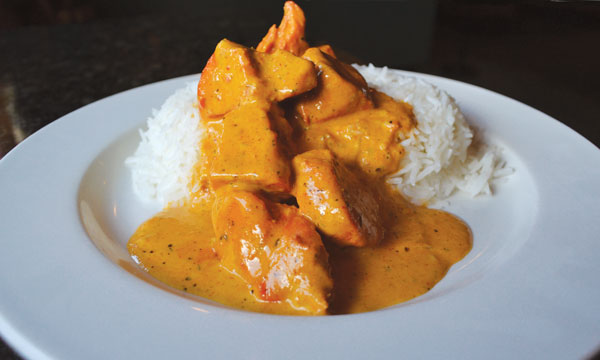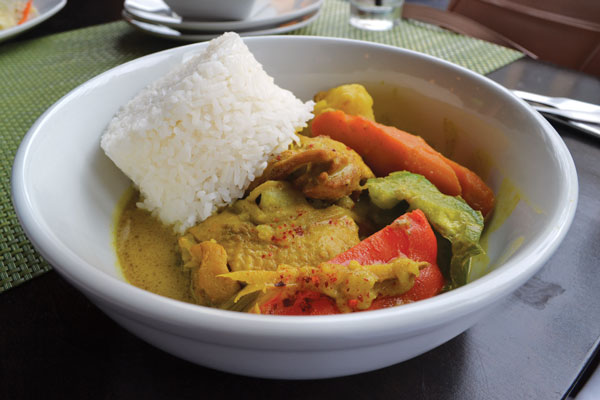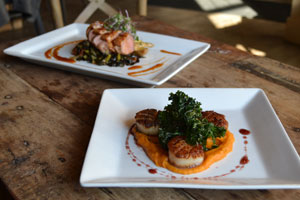Spice Nirvana
The FOX CITIES Magazine guide to curry
In the United States and much of the West, “curry” is a catchall term for any spicy, saucy dish of South Asian origin. The reality, however, is much more complex. From India to Thailand, curries come in countless variations that are influenced by local ingredients and regional traditions.
In India, the birthplace of curry, you’ll find lentil-based curries and dishes that use yogurt or ghee (clarified butter). Thai curries will often use coconut milk and a curry paste that includes fresh ingredients such as lemongrass, lime leaves and ginger.
Scott Finley, chef and culinary arts & hospitality instructor at Fox Valley Technical College in Appleton, has roughly 45 curry recipes in his arsenal.
“There’s not one exact recipe for curry,” he says. “Curry recipes are very generational and are developed among families, so they can be very different. They will also have different applications depending on the culture.”
Siva Rajarathinam, owner of Sai Ram Indian Cuisine in Appleton, says Indian food is a perfect example of this, as cooking styles differ widely throughout the country.
“In India, each state has its own language, its own culture, its own food,” he says. “A lot of people think makhani and tikka masala are the same, but when you eat it, they are completely different.”
One thing that is true for most curries is that they start with a base, usually a blend of dry spices or a wet paste. Larry Chomsisengphet, general manager of Basil Cafe in Appleton, says their curry paste, which serves as the foundation for the restaurant’s traditional curry dishes, starts with soaking both fresh Thai chilies and dried Szechuan chilies overnight. The chilies are ground with Lao blue rooted ginger, lemongrass and kaffir lime leaves.
“After all the ground up ingredients are mixed, we then sauté this with a lot of oil over low heat for over an hour,” Chomsisengphet says. “This draws out the flavors and capsaicin from the peppers, and releases the flavors of the other herbs.”
The complexity of curries can be intimidating to home cooks wishing to try their hand at an authentic dish. Rajarathinam says when it comes to curry, practice really does make perfect.
“It’s not like a sandwich that can just be put together,” he says. “It takes a lot of time to understand before the flavor comes.”
Color-Coded Curry
Taste of Thai Owner Natcha Jitmaiwong breaks down the difference between three popular Thai curries.
Yellow: Yellow curries tend to be mellow and more closely resemble Indian curries. Jitmaiwong says Taste of Thai adds peanut paste to their yellow curries for a hint of sweetness.
Red: Red curry packs a punch, as its base is made from red chilies. Spicy and bold, many people enjoy the up front heat of red curry. Jitmaiwong recommends it if you’re looking for high spice levels.
Green: While green curry is still spicy, Jitmaiwong says it’s more of a slow burn. “When you taste red curry, the spice kicks you right away. Green curry is smooth at first and the spice kicks you later.”
Curry On
From soup to sushi, curry in the Fox Cities takes many forms. Here are seven must-try dishes.
 The dish: Kow Boon
The dish: Kow Boon
Basil Cafe in Appleton serves up a traditional Lao rice vermicelli noodle curry soup, called kow boon, which is revered for its soul-soothing properties. To make the soup, curry paste is mixed with ginger, lemongrass and lime leaf-infused chicken broth. Shredded chicken breast is added to the slightly spicy coconut curry broth and is topped with bamboo shoots, mint and cilantro. The soup is served with bean sprouts, limes, mint, cilantro, lettuce and, more traditionally, cabbage and chopped banana flower blossom. “It’s sort of like phó where you can add all of these extra herbs and ingredients to make it your own,” says General Manager Larry Chomsisengphet. (FYI – Basil Cafe is currently closed for summer vacation, but will reopen September 5.)
 The dish: Godzilla Roll
The dish: Godzilla Roll
At Katsu-Ya of Japan in Appleton, sushi gets the deluxe treatment with the addition of a special curry sauce made with mayonnaise, curry powder and a couple secret ingredients. The curry sauce is smooth and complements the fresh ingredients found in both the Godzilla and veggie curry rolls. The Godzilla roll is made with a shrimp jalapeño popper at the center, and is topped with tuna tartar and curry sauce. The veggie curry roll is drizzled with the same curry sauce, but is made with cucumber, avocado, asparagus, cream cheese and cilantro before being rolled in sesame seeds.
 The dish: Curry Chips
The dish: Curry Chips
Eric Buss, manager of McGuinness Irish Pub in Appleton, says most people don’t think of curry as an Irish food, but it’s a culinary staple throughout the country. “In Ireland after a night out on the town, you go to a chip shop or a ‘chipper,’” Buss says. “It’s the standard late-night pub grub.” In this tradition, McGuinness serves curry chips — thick-cut french fries with an imported curry sauce on the side. Buss describes the sauce as a blend of red and yellow curry that’s a bit on the sweeter side with mild heat.
 The dish: Chicken Makhani
The dish: Chicken Makhani
Sai Ram Owner Siva Rajarathinam says chicken makhani, otherwise known as “butter chicken,” is a gateway curry. In fact, he often sees diners follow the same Indian food evolution. “It starts with makhani,” he says, “then it goes to tikka masala, then curry and then we bring the spiciest, vindaloo.” While these dishes are often treated with a blanket reference of “curry,” they are all different. “We start with the same main ingredients like chilies, coriander and black pepper, but each dish is prepared in a different way, which is how you get the different flavors.” Mild and creamy, makhani is a dish that originated in Delhi and is made by mixing butter and tomato puree with spices such as cumin, cloves, cinnamon, coriander and fenugreek.
 The dish: Lodeh
The dish: Lodeh
At Java Warung in Appleton, an entire section of the menu is dedicated to curry. Owner and head chef Enny Pickett says lodeh is a vegan green papaya stew made with tropical mixed vegetables and one of her personal favorites. Pickett makes three different curry pastes that are the base for all the curries at Java Warung. She blends ingredients such as garlic, shallots, coriander, galangal and turmeric in a food processor and then sautes the paste to bring the flavors out. Pickett assures that while the curries are flavorful, they aren’t “hot.” “Indonesian curry is very subtle,” she says. “People don’t need to be scared.” (FYI – Java Warung is currently closed for summer vacation, but will reopen August 24.)
 The dish: Evil Jungle Prince
The dish: Evil Jungle Prince
The darling of the Thai curry world is certainly massaman, with it’s mildly sweet and creamy disposition. This holds true at Taste of Thai in Appleton where Owner Natcha Jitmaiwong says the massaman curry is one of their most popular dishes. Those looking to branch out should try Jitmaiwong’s favorite, Evil Jungle Prince, which combines two curries. “We mix it up with red curry and massaman curry so that’s why it’s really tasty,” Jitmaiwong says. Evil Jungle Prince features chicken, beef or pork that is sautéed in coconut milk and served with mixed vegetables and fresh basil. If you want it really spicy, simply ask and the chef will add fresh chilies for extra heat.
 The dish: Chicken curry
The dish: Chicken curry
Diners can experience a Filipino take on curry at Manila Resto in Oshkosh.. “If you can categorize Filipino food, it was Asian fusion before Asian fusion came out,” says Owner Marlo Cuaresma Ambas. “There’s tons of influences from neighboring countries like Malaysia.” Manila’s Malaysian-inspired curry includes potatoes, carrots, green and red bell peppers, and either chicken or seafood, but chicken tends to be traditional. Based on Northern Filipino cuisine, Manila’s dishes are flavorful without being heat-forward so don’t worry about burning your tastebuds off. Looking for an interesting way to enjoy your meal? The restaurant recently introduced the Fox Valley to a new dining concept – the boodle fight. Originating from a tradition in the Philippine military, a boodle fight is when soldiers would dine communally at long, banana leaf-covered tables. A variety of food is served atop a bed of rice directly on the leaves. “It’s a sign of brotherhood and that everyone is of equal ranks,” Ambas says. Groups of two or more can book a boodle at Manila at least three days in advance.
Bonus Recipe: Basic Dry Curry Blend
The experts agree – when possible, make your own curry blend or paste for the best flavor. This recipe provided by Chef Scott Finley should get you started.
4 Tbls coriander seeds
2 Tbls cumin seed
4 tsp black peppercorns
3 tsp mustard seed
2 Tbls fenugreek
5-6 cloves
5-6 dried chilies or 2 Tbls chili flakes
1-2 tsp turmeric
Add all ingredients except turmeric to a dry, heavy skillet and toast. Once lightly browned and fragrant, add the turmeric and stir for 10-15 seconds. Allow to cool. Transfer spices to a coffee grinder and grind until smooth. Store in airtight container.










Leave a Comment